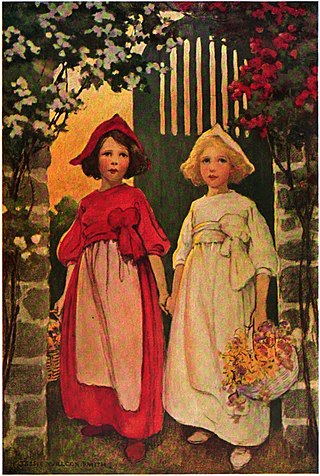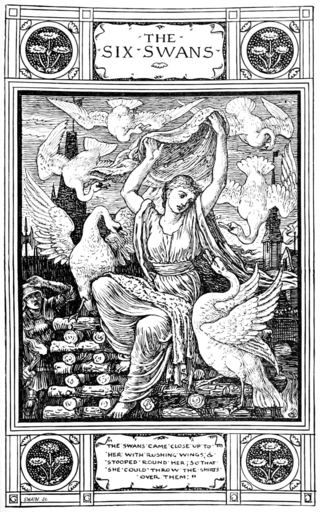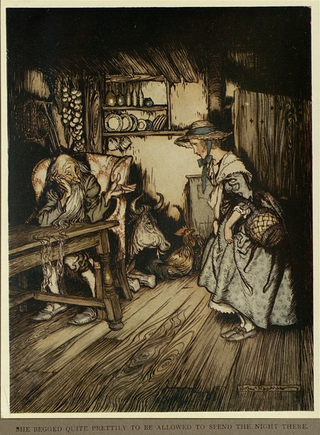The Young Slave is an Italian literary fairy tale written by Giambattista Basile in his 1634 work, the Pentamerone . [1]
It is Aarne-Thompson type 709, Snow White; other variants include Bella Venezia and Myrsina . [2] The tale is based in Italy, and is often cited as one of the first Snow White stories to exist.
A few girls competed to see who could jump over a rose bush without touching it. Lilla, the baron's sister, was the last to go. She almost cleared the bush, but knocked off a single rose petal, signifying her loss. However, wanting to win, she decided to swallow the petal and claim victory. That night, she became pregnant. She confided in her fairy friends about what had happened, confused because she was a virgin, but the fairies told her not to worry, because it was the rose petal itself that had impregnated her. Eventually she bore a daughter and named her Lisa. The fairies gave Lilla gifts to commemorate the birth, but one twisted her ankle and accidentally cursed Lisa to die when she was seven. The cause of death would be by Lilla herself combing her daughters hair and forgetting about it, causing the comb to become poisonous and kill her. When Lisa turned seven, the curse became true, and Lilla fell ill. The lamenting mother put her daughter in seven crystal coffins and hid her away in a room. Before she died, she gave her brother the key to the room and made him promise not to open it.
He obeyed and, eventually, married. He was always out hunting, and during one of his trips, his wife opened the door and found the casket. Lisa had continued to age into a beautiful young girl and the casket grew with her. Jealous of the girl's beauty and believing that her husband would cheat on her with Lisa, the baroness pulled her out by her hair, which knocked out the comb and brought her back to life. She cut the girls hair, dressed her in rags and beat her everyday until her husband returned. When her uncle returned, he could not recognize her as his niece, and his wife took advantage of this. She claimed that her aunt had sent her the girl to be their slave, and that she was not to be loved. She forced the girl to do work around the house and continued to abuse her.
One day, the baron went to a fair and asked everyone for what they wanted him to bring back, including Lisa. His wife flew into a jealous rage, stating that she was not to be loved or put on their social level. Lisa then asked for a doll, a knife, and some pumice-stone, and cursed him to not be able to cross the river to return if he failed. He indeed forgot them, but when the river swelled, it reminded him of her request, and he went back to buy her items. Lisa took them to the kitchen and told her life story to the doll, and then threatened to sharpen the knife on the stone and kill herself if the doll did not answer. Miraculously, the doll replied "Alright, I heard you! I'm not deaf!" Lisa continued this game with her doll over several days - threatening to kill herself with the knife if the doll did not reply.
By chance, the baron heard Lisa speaking to the doll one night. Recognizing the story of the rose bush, he broke down the door just before Lisa could stab herself with the knife. He asked her to retell the story, and she did, and he instantly knew that she was his niece. He embraced the girl and sent her away from the abusive home to one of his relatives, where she could recover. In a few months time, Lisa had once again regained her "goddess-like" beauty and was invited back to the home. The baron planned a great banquet for the kingdom and, when the meal was finished, asked Lisa to recount the horrors his wife had put her through. The people at the banquet were horrified and sobbing, angry at the baroness, until finally the baron banished his wife from his land and out of their lives forever. He found a handsome, loving husband for his niece of her choosing, and they lived happily ever after. [3]
Folklorist D. L. Ashliman classified the tale in the Aarne-Thompson-Uther Index as type ATU 709, "Snow White", in his 1987 study of folktales. [4] Similarly, Maria Tatar considered it a version of "Snow White". [5]
On the other hand, scholar Nancy Canepa classified it as type ATU 410, "Sleeping Beauty", and ATU 894, "The Ghoulish Schoolmaster and the Stone of Pity", although she recognized that the story "shared motifs" with "Snow White", e.g., the comb and the glass coffin. [6]
In another line of scholarship, Spanish scholars Julio Camarena and Maxime Chevalier, in their joint Spanish Folktale Index, classified the tale as a new Spanish tale type: 438, "La Hija de la Rosa" (English: "The Daughter of the Rose"). In this type, the heroine's mother either swallows a rose petal, or sleeps beneath a rosebush, thus causing her to become pregnant with the heroine; later in life, the heroine is put to sleep by a magic comb, but wakes up in a prince's castle; at the end of the tale, the heroine tells her woes to a "piedra del dolor" (or a stone of pity), and tries to kill herself when the prince stops her. [7]

"Snow-White and Rose-Red" is a German fairy tale. The best-known version is the one collected by the Brothers Grimm in 1837 in the third edition of their collection Grimm's Fairy Tales. It was first published by Wilhelm Grimm in 1827 in Wilhelm Hauff's Märchen-Almanach. An older, somewhat shorter version, "The Ungrateful Dwarf", was written by Caroline Stahl (1776–1837). Indeed, that appears to be the oldest variant; no previous oral version is known, although several have been collected since its publication in 1818. Oral versions are very limited regionally. The tale is of Aarne-Thompson type 426.
The Aarne–Thompson–Uther Index is a catalogue of folktale types used in folklore studies. The ATU Index is the product of a series of revisions and expansions by an international group of scholars: originally composed in German by Finnish folklorist Antti Aarne (1910), the index was translated into English, revised, and expanded by American folklorist Stith Thompson, and later further revised and expanded by German folklorist Hans-Jörg Uther (2004). The ATU Index, along with Thompson's Motif-Index of Folk-Literature (1932)—with which it is used in tandem—is an essential tool for folklorists.

The Pentamerone, subtitled Lo cunto de li cunti, is a seventeenth-century Neapolitan fairy tale collection by Italian poet and courtier Giambattista Basile.

"The Six Swans" is a German fairy tale collected by the Brothers Grimm in Grimm's Fairy Tales in 1812. It is of Aarne–Thompson type 451, commonly found throughout Europe. Other tales of this type include The Seven Ravens, The Twelve Wild Ducks, Udea and her Seven Brothers, The Wild Swans, and The Twelve Brothers. Andrew Lang included a variant of the tale in The Yellow Fairy Book.

The Three Heads in the Well is a fairy tale collected by Joseph Jacobs in English Fairy Tales.

"The Hut in the Forest" is a German fairy tale collected by the Brothers Grimm. Andrew Lang included it in The Pink Fairy Book (1897). It is Aarne-Thompson type 431.

The Lute Player, The Tsaritsa Harpist or The Tsaritsa who Played the Gusli, is a Russian fairy tale. It was published by Alexander Afanasyev in his collection Russian Fairy Tales, as number 338. Andrew Lang included it in The Violet Fairy Book (1901).
Prunella is an Italian fairy tale, originally known as Prezzemolina. Andrew Lang included it in The Grey Fairy Book. It is Aarne-Thompson type 310, the Maiden in the Tower.
"The She-bear" is an Italian literary fairy tale, written by Giambattista Basile in his 1634 work, the Pentamerone.
The Flea is an Italian literary fairy tale written by Giambattista Basile in his 1634 work, the Pentamerone. It combines Aarne-Thompson-Uther types 857, "The Louse-Skin" and ATU 653, "The Four Skillful Brothers".
"The Three Sisters" or Green Meadow is an Italian literary fairy tale written by Giambattista Basile in his 1634 work, the Pentamerone. It tells the story of a maiden having secret encounters with a prince with the use of magic, him almost losing his life and her having to search for a cure for him.
Biancabella and the Snake is an Italian literary fairy tale written by Giovanni Francesco Straparola in The Facetious Nights of Straparola.
Penta of the Chopped-off Hands or The Girl With the Maimed Hands is an Italian literary fairy tale written by Giambattista Basile in his 1634 work, the Pentamerone.
Sapia Liccarda is an Italian literary fairy tale written by Giambattista Basile in his 1634 work, the Pentamerone. It is not known whether he had a specific source, either literary or oral, for this tale.
The Sleeping Prince is a Greek fairy tale collected by Georgios A. Megas in Folktales of Greece.
Nourie Hadig is an Armenian fairy tale collected by Susie Hoogasian-Villa in 100 Armenian Tales. Her informant was Mrs. Akabi Mooradian, an Armenian living in Detroit.
The Crow is a Slavic fairy tale of Polish origin, translated by Hermann Kletke as Die Krähe, in his folktale compilation Märchensaal aller Völker. Andrew Lang included it in The Yellow Fairy Book.
The Calumniated Wife is a motif in traditional narratives, numbered K2110.1 in Stith Thompson's Motif-Index of Folk-Literature. It entails a wife being falsely accused of, and often punished for, some crime or sin. This motif is at the centre of a number of traditional plots, being associated with tale-types 705–712 in the Aarne–Thompson–Uther Index of tale-types.
In folkloristics, "The Animal as Bridegroom" refers to a group of folk and fairy tales about a human woman marrying or being betrothed to an animal. The animal is revealed to be a human prince in disguise or under a curse. Most of these tales are grouped in the international system of Aarne-Thompson-Uther Index under type ATU 425, "The Search for the Lost Husband". Some subtypes exist in the international classification as independent stories, but they sometimes don't adhere to a fixed typing.
The Padlock is a literary fairy tale written by Giambattista Basile in the Pentamerone, as the ninth story of the second day.